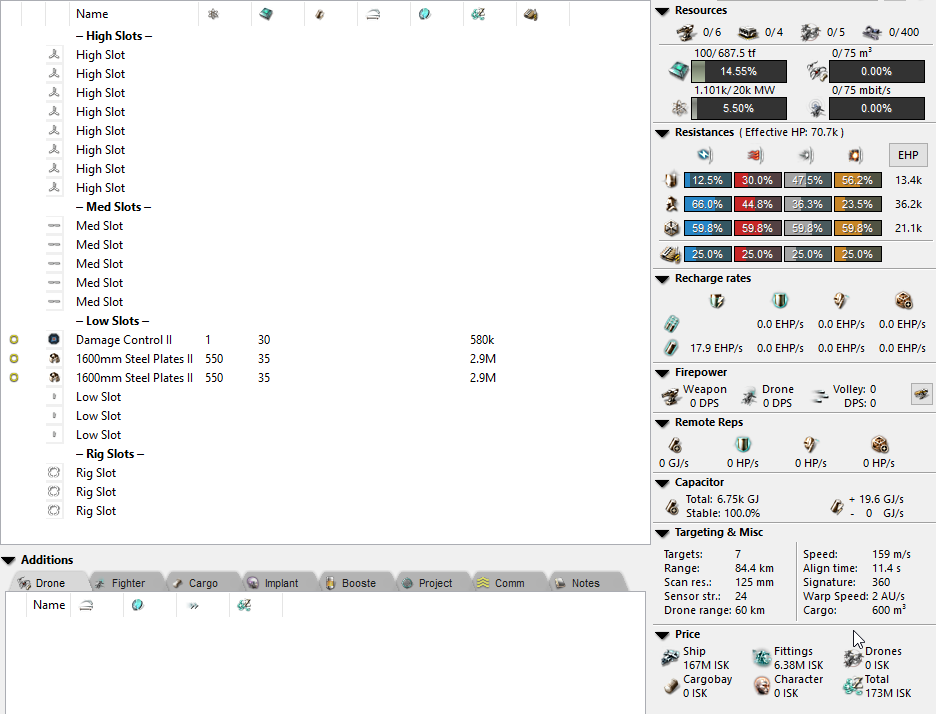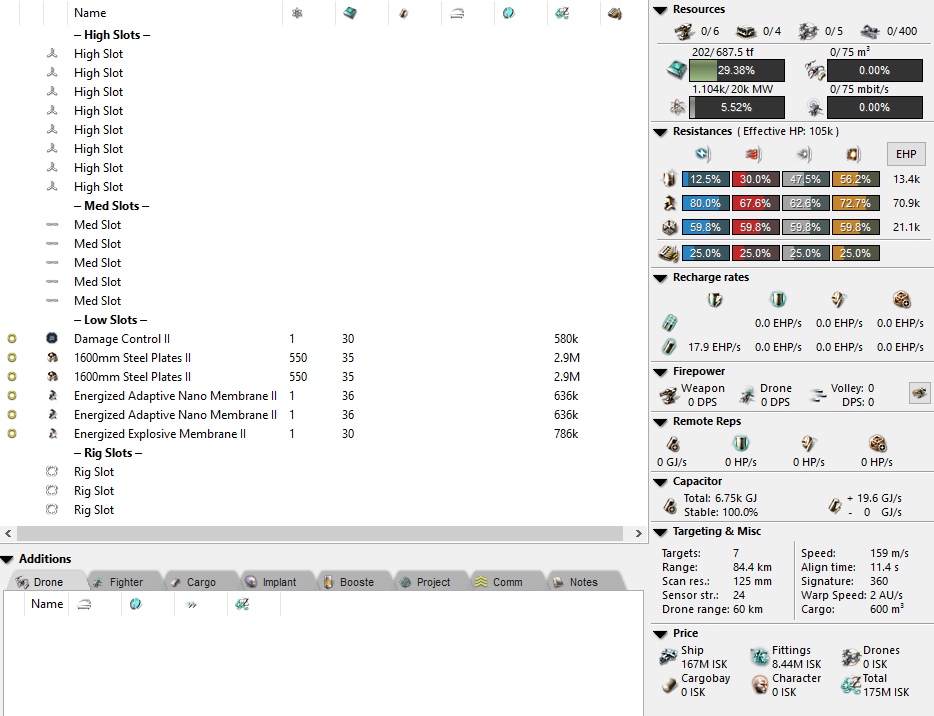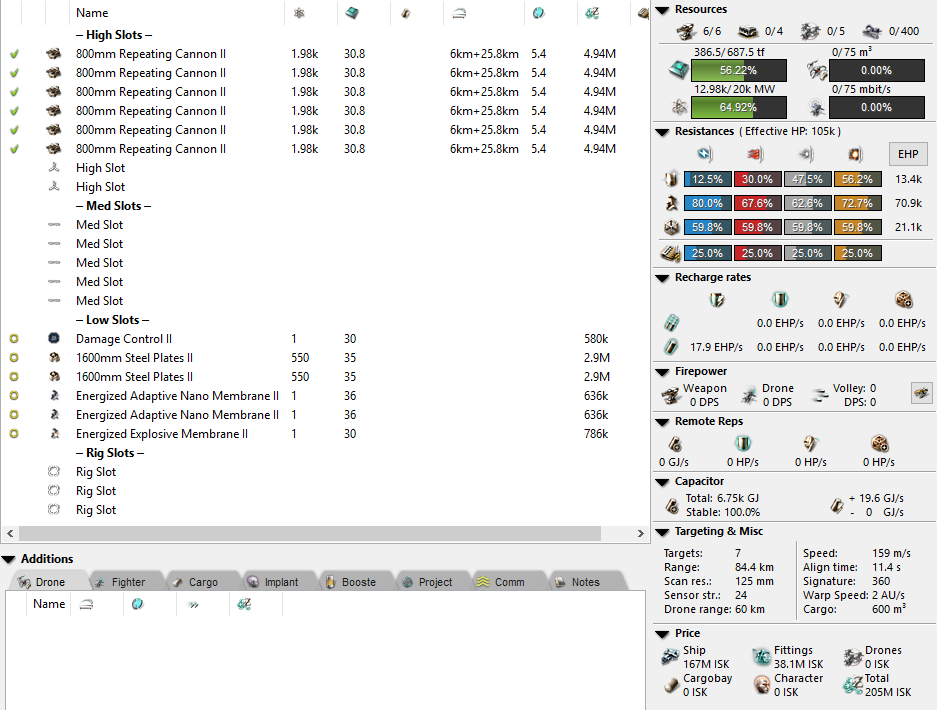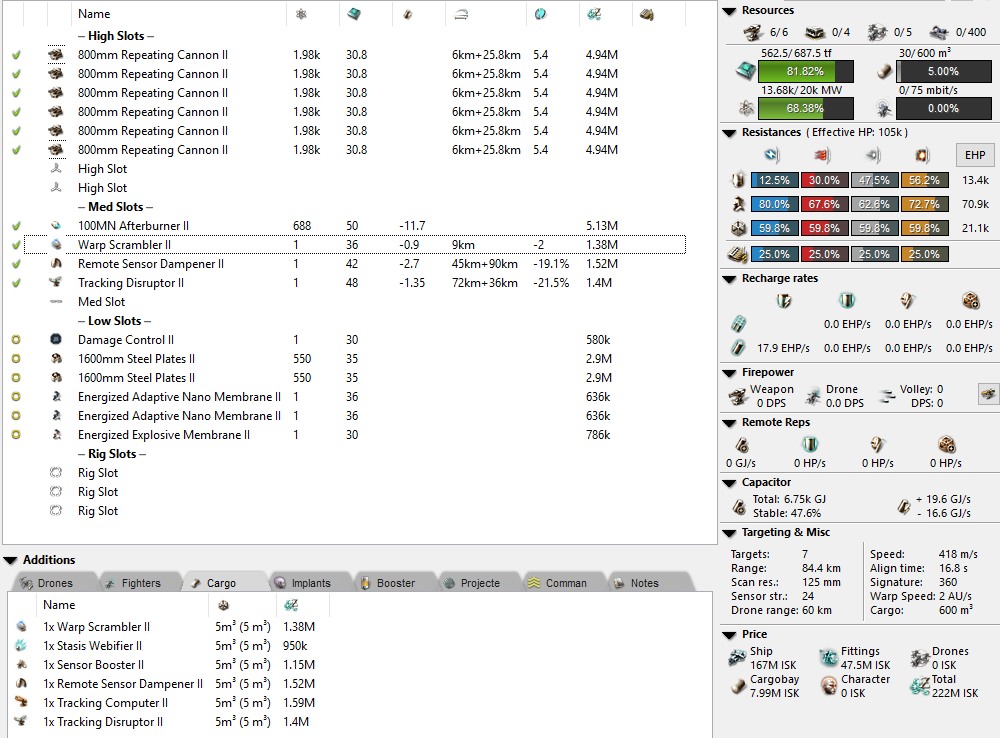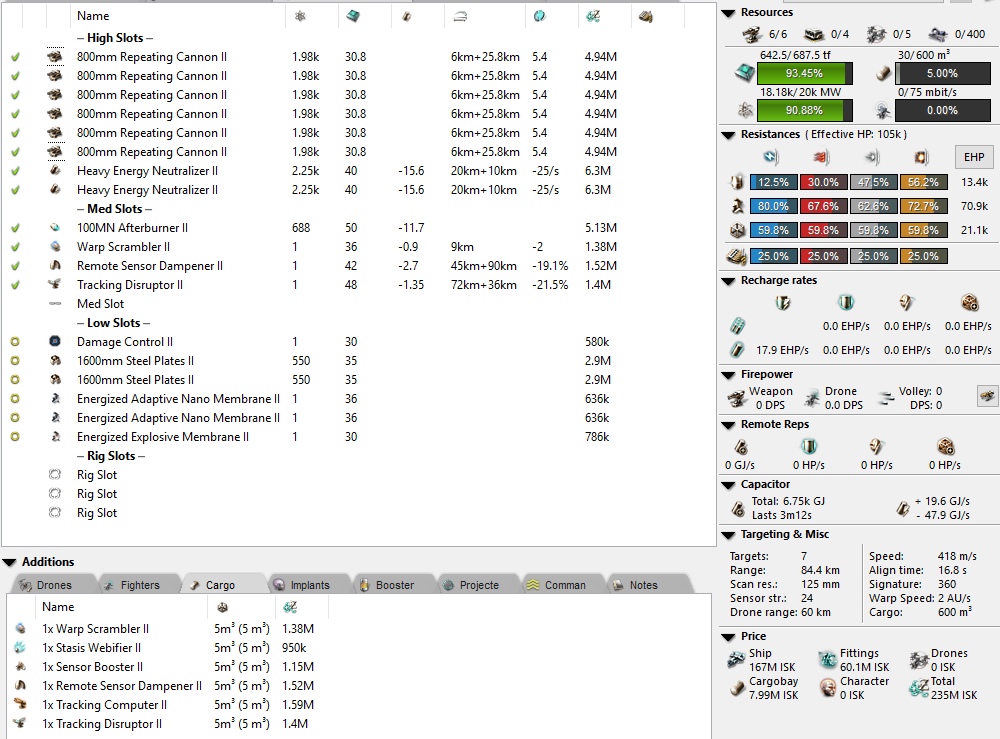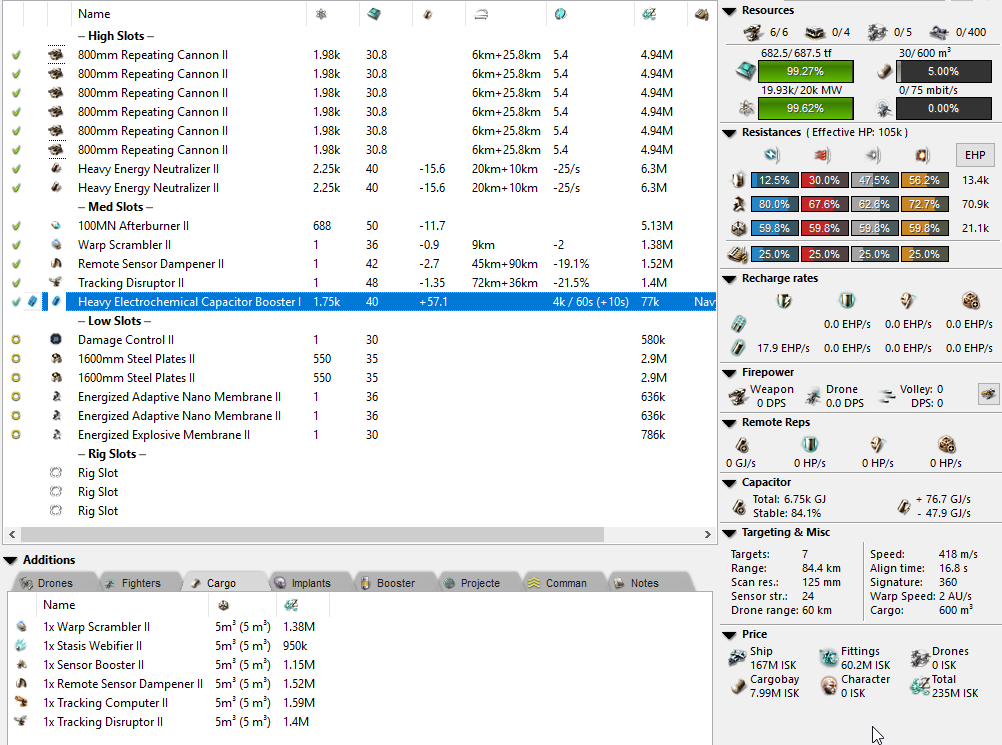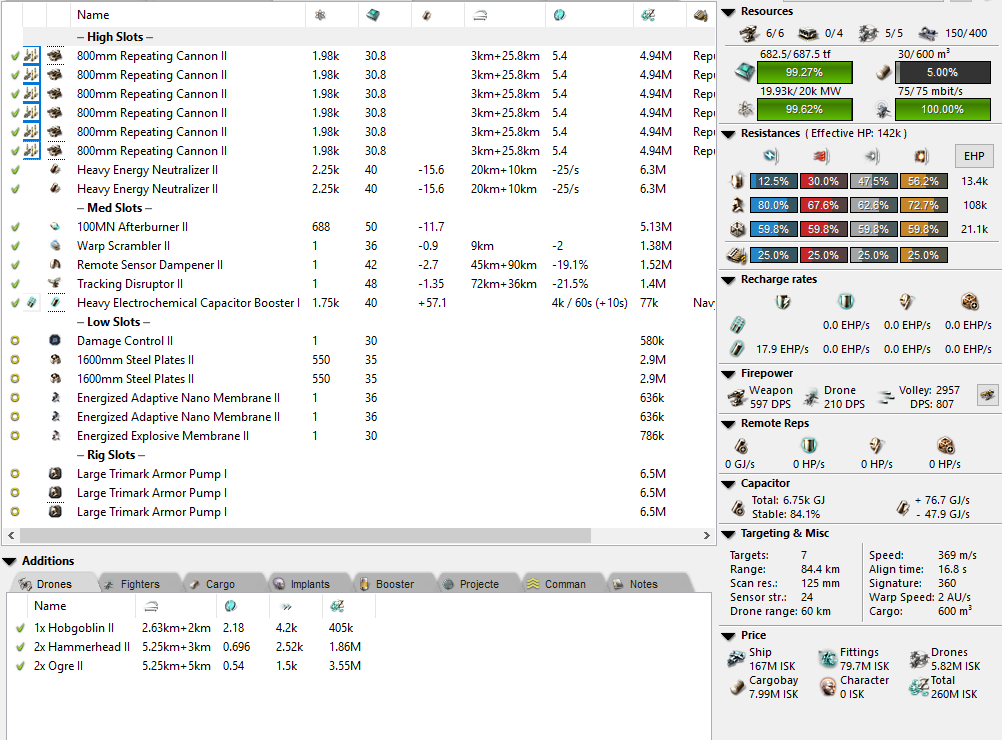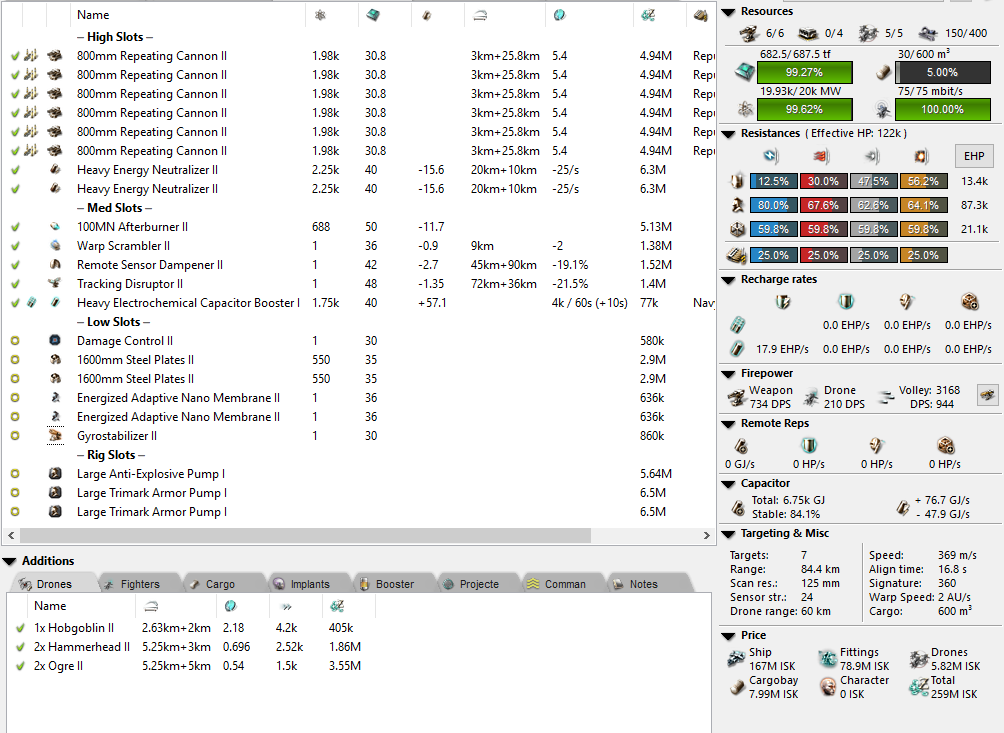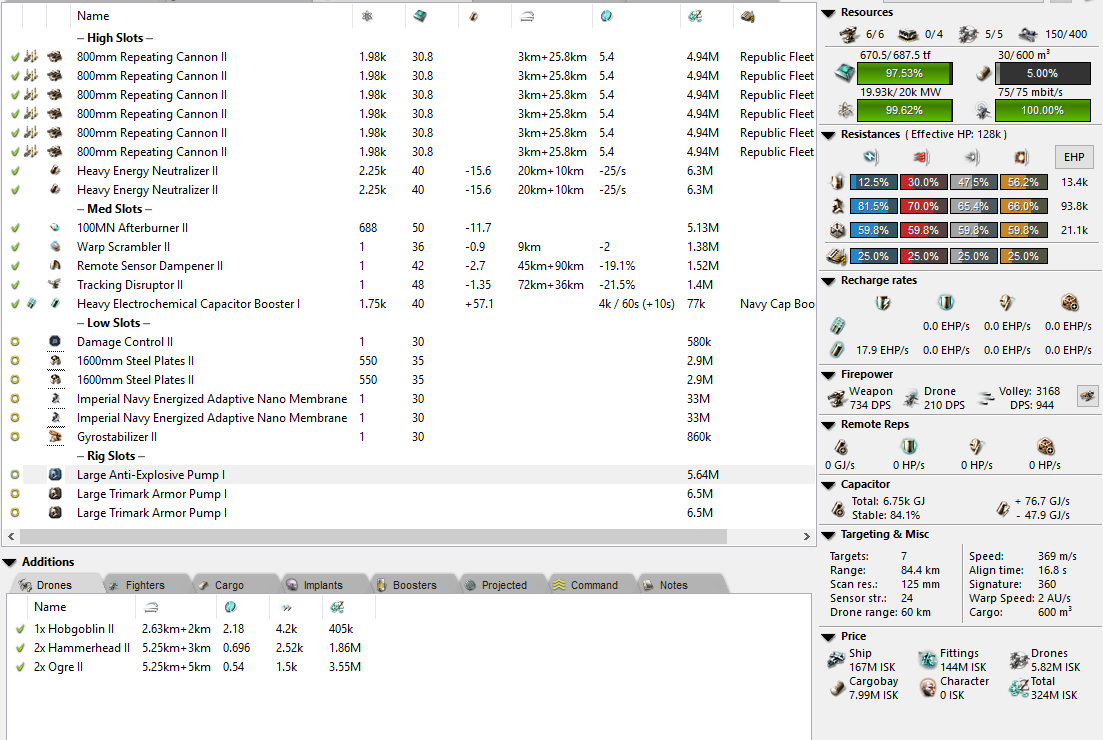The reason is: Tone.
Fitting any ship is a dense, complex process involving many trade-offs. Devising a potentially-viable fit that might work for a group doctrine can be even more challenging. This page lays out some of the thinking and questions involved; the exact details of the fit crafted here are not necessarily current to the present game mechanics due to updates, but the principles remain useful.
Who Devises Fits?
Anyone can create a fit. Whether or not that fit is good is a different question. Coming up with doctrine fits that can be used at an alliance level is a long process that requires everything from a ground-level understanding of the basic items you should probably fit (such as propulsion, tank, and role modules), right up to the slight differences in various types of the same module and the repercussions that fitting that module will have (fitting space, stat alterations, etc).
A good theorycrafter or fit-crafter and a good fleet commander are not the same thing. One player might be a brilliant fit analyst, able to decide what meta-level of MWD a Machariel needs and why it should mount 800mm autocannon instead of 650mm artillery, but not able to command a fleet of fitted Machariels. Some fleet commanders are not (and need not be) expert theorycrafters. Some players are neither gifted commanders nor gifted theorycrafters: there are many other ways to "be good at" EVE and to contribute to your corporation.
Where to Start?
We'll assume that you already know the ship you will be creating a fit for. Let's imagine you have been asked to create a fit for an '"armor fleet brawling Tempest". That's enough of a goal to begin with
We strongly suggest you download and use a third-party fitting tool, such as PYFA. The in game fitting tool is ok, but nowhere near as easy and quick for prototyping new fits.
We'll start with the hull itself first. You want to think about the bonuses the ship gets, even if you know them automatically. Per pilot level of Minmatar Battleship, the Tempest gets:
- a 7.5% bonus to Large Projectile Turret rate of fire
- a 5% bonus to Large Projectile Turret damage
There are also a few other things we need to ask ourselves first:
- How do other people fit this ship?
- How should I make use of the ship bonuses?
- How should I balance tank, damage and utility?
- Do I need a propulsion module and if so, what should I fit?
- Will everything fit within the ship's CPU and powergrid?
- How blingy should I make it?
- What other modules or rigs should I fit?
Broader contextual facts should affect your answers to these questions. For example, a theorist crafting a fit for a selective PvP corporation which requires 50 million character skill points for applicants to be eligible for consideration can expect perfect or near-perfect fitting skills—and therefore more ability to put loads on the CPU and powergrid—and also substantial resources available to put expensive faction modules ("bling") on the ship. The same theorist crafting a fit for an organisation such as EVE University, which specializes in fostering newer players, might want to consider more forgiving fitting requirements and cheaper modules or, at least, a "new player friendly" second version of a fit which is less demanding. Since the ship at hand in our example is a battleship, we might expect relatively good character skills and ISK resources.
Step 1: Copy
So, let's start with the sincerest form of flattery: imitation. We look at what people have been flying:
- https://zkillboard.com/kill/62308245/ - Hmm, not what we want, this is a self-repairing fit, and we don't want that for fleets at all. Also, the guy died to war targets in Jita, so maybe we had better not mimic that fit (what is that rig for?). We'll ignore this one for now.
- https://zkillboard.com/kill/62256626/ - No, wedefinitely don't want a ship for rolling wormholes.
- https://zkillboard.com/kill/62070065/ - Okay, this is more like it. He died with a group of his friends and had logistics support, if you check related kills.
In practice, a theorist working on an alliance doctrine might look through many more zkill entries than this, but let's stop here for now.
So looking at the above fit, take note of what it has fitted:
- Armor Plates - for buffer
- Autocannon - the closer-range projectile weapon (check the Tempest's bonuses to large projectiles again)
- Microwarpdrive - for manoeuvring
- Cap Booster - to avoid running out of capacitor
- Utility Neuts - for capacitor warfare
Step 2: Make Your Fit
We'll start in Pyfa, by fitting a few basics to our empty Tempest. The balance between tank and damage is important; one must be fitted before the other, but then both must be weighed against each other. In this example, let's fit tank first, to begin by double-checking that the ship will actually stay alive longer than a few seconds.
We know we need tank, so we'll fit 2 armor plates like the fit above. (Most battleships will fit 2 1600mm armor plates for armor fleet fits.) We'll also fit a Damage Control, a fantastic module that does not get stacking penalized by other resist mods, and boosts resistance to damage across all of shield, armor and hull. (As a rule of thumb, don't fit a fleet PVP ship without buffer.)
We have three low slots left now. Perhaps we need some armor resistance? Let's throw on a few Energized Adaptive Nano Membranes. We only really want two on there, because stacking penalties will hit us quite hard after that. Finally, our explosive resist is quite low, so let's throw on an explosive membrane on too.
We probably need some weapons, so let's grab some 800mm autocannon. We definitely don't want artillery (the other form of projectile turret), because they are not designed for brawling, and brawling was our starting-point goal. Artillery is better-suited for longer ranges, as its tracking speed is horrendous up close. Artillery it also has a huge cycle time.
We've still got quite a bit of room left after we fit the 800mms.
We'll probably want to fit a propulsion module of some sort to get around the battlefield.
Both afterburners and MWDs have their proponents for brawling battleships. MWDs offer much higher speeds, but fitting one reduces the ship's entire capacitor pool, and a warp scrambler will shut an MWD down. Running an MWD also blooms a ship's signature, making it easier to hit with turrets and easier to hurt with missiles. Afterburners don't have these drawbacks, and use less capacitor to run, but offer a far smaller speed boost. In practice, lots of factors would weigh on this choice; let's take an afterburner for now.
After we've stuck a propulsion module on, we need to decide a few other things in the mid slots. Usually, for this type of fit, we'll have several "refits" for our mid slots that are designed to be switched around depending on what you are fighting. For now, we'll add a scram (for tackle or boosh resistance), a sensor dampaner, and a tracking disruptor. We can add some refit mods to the cargohold just in case. The reason we fit these is that they use the spare mid slots freed up by using an armor tank in order to apply additional pressure to our enemy. A Tracking Computer might be another good option here.
One mid slot is empty for now. There are two empty high slots on the Tempest that remain even when its turret hardpoints are all filled. You can put missile launchers on there, but they won't have any hull bonuses to damage. A strong alternative option is heavy energy neutralizers, which can have a devastating impact on the capacitors of small- and medium-sized ships that stray too close. However, with two heavy neuts active, alongside our mid slots running, we run out of capacitor in 3 minutes.
While that's not terrible, you also don't want to be in a situation where you are neuted back and you have to drop your tackle, electronic warfare and propulsion. So we'll throw a capacitor booster on. It has to be a meta level one as otherwise you run out of powergrid.
We're just missing a few finishing touches. Let's load the guns with some default close-range, high-damage ammo, add some drones, and finalize rigs.
Pictured here is the optimal drone choice for maximum DPS: 2 heavies, 2 mediums and 1 light. They will be vulnerable to smartbombing, as they will fight close to their target, and they will also spend time not applying DPS as they move between targets. The alternative is to fit sentry drones. They do less DPS, but you can drop them in a safer place and they'll stay alive longer (and have no travel time).
Let's—for the sake of this fit—try spending all the rig slots to increase the buffer tank.
And here we have our first iteration of a fit.
Step 3: Tweaking the Fit
Once you have what you think is a complete fit, you must play devil's advocate and decide whether it is truly "perfect".
I've purposely chosen a simple ship to work with here, as there's really not a huge deal wrong with the original fit at all. What you could say, however, is that dedicating all of your available slots to tank is quite considerable. The damage output is also not fantastic. So, let's have a think what we can do in a situation where we wanted to increase our damage.
We could remove a plate to fit a Gyro, but that would significantly reduce the raw armor hp on the ship, giving the pilot and logi less time to react to a target switch. Not something we want to do. We could also remove one of the Energized Adaptive Nano Membranes. But that leaves us with very low resists for thermal/kinetic. How about that explosive membrane? If we remove that, our explosive resist drops from 72.7% to 55.1% and our overall EHP from 142k to 128k. Not ideal. What what else can we do with that? How about if we remove a trimark, and fit an anti-explosve pump instead? Then throw a Gyro in its place.
So our dps has gone from 807 to 944 combined. An increase of 17%. However our tank has dropped a bit to 122k EHP from 142k, a 14% drop. We could argue that our resists are much closer together now and the high explo resist would really not have helped us much in the previous iteration. We did lose some buffer by making this change though as we had to replace a trimark. This is probably a more well balanced fit, however, as the damage output is significantly higher.
Final Thoughts
So, did we achieve what we set out to do? I think so, yes. We made a perfectly capable armor fleet fit brawling tempest. Someone else may have come up with a slightly different fit, but that's the joy of EVE. Nothing is ever 100% correct and even in the example above, there will most likely have been a time where you wished for that extra buffer over the increased damage the gyro gave you.
Why did I not fit green/blue mods? Well, there is no real answer to that that can cover all situations, unfortunately. For this instance I could well have fitted a few. Take the fit below as a good example. It's not overly pricey, but the extra expense isn't totally wasted. We gained some good resists and 8k EHP for 60mil ISK.
When you make decisions like that you have to ask yourself if the increase is really worth the expensve. For something like a T1 battleship, you wouldn't really go all out on bling. Faction battleship, perhaps yes, I wouldn't hesitate fitting A type deadspace mods to a Machariel, but not to a Tempest. Maybe not even to a Tempest Fleet (I'd probably stick faction on however).
As a rough guide, if you're spending around the same on mods as you are on the hull, you're in the right ballpark. If that number starts creeping up, you just need to make sure you know what you are doing.

